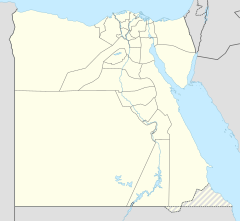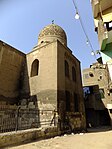
Sultan Abu Al-Nasr Sayf ad-Din Al-Ashraf Qaitbay was the eighteenth Burji Mamluk Sultan of Egypt from 872–901 A.H.. He was Circassian by birth, and was purchased by the ninth sultan Barsbay before being freed by the eleventh Sultan Jaqmaq. During his reign, he stabilized the Mamluk state and economy, consolidated the northern boundaries of the Sultanate with the Ottoman Empire, engaged in trade with other contemporaneous polities, and emerged as a great patron of art and architecture. In fact, although Qaitbay fought sixteen military campaigns, he is best remembered for the spectacular building projects that he sponsored, leaving his mark as an architectural patron on Mecca, Medina, Jerusalem, Damascus, Aleppo, Alexandria, and every quarter of Cairo. To some historians, he is infamous for building a fortress on the remains of the ancient wonder, the Lighthouse of Alexandria, in 1480, resulting in the final disappearance of the lighthouse, confining it to the history books.

The Mosque-Madrasa of Sultan Hassan is a monumental mosque and madrasa located in the historic district of Cairo, Egypt. It was built between 1356 and 1363 during the Bahri Mamluk period, commissioned by Sultan an-Nasir Hasan. The mosque was considered remarkable for its massive size and innovative architectural components, and is still considered one of the most impressive historic monuments in Cairo today.

The Az-Zahiriyah library or Madrasa al-Zahiriyya is a historic library, madrasa, and mausoleum in Damascus, Syria. It dates back to 1277, taking its name from Sultan al-Zahir Baybars (1223–1277) who is buried here.
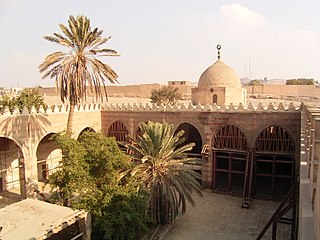
The Aqsunqur Mosque is located in Cairo, Egypt and is one of several "blue mosques" in the world. It is situated in the Tabbana Quarter in Islamic Cairo, between Bab Zuweila and the Citadel of Saladin The Aqsunqur Mosque also serves as a funerary complex, containing the mausoleums of its founder Shams ad-Din Aqsunqur, his sons, a number of children of the Bahri Mamluk sultan an-Nasir Muhammad and that of its principal restorer, Ibrahim Agha al-Mustahfizan.
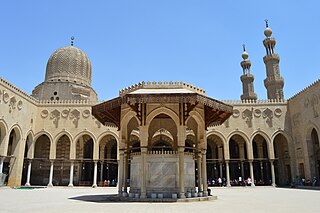
The Mosque of Sultan al-Mu'ayyad is a Mosque in Cairo, Egypt next to Bab Zuwayla built under the rule of sultan Al-Mu'ayyad Sayf ad-Din Shaykh from whom it takes its name, "Al-Mu'ayyad", meaning The Supporter in Arabic language. Construction began in 1415 and the mosque was completed in 1421. The complex included a Friday mosque and a madrasa for four madhhabs. It replaced a prison which originally stood next to Bab Zuwayla.

Fountain of Qayt Bay or Sabil Qaitbay is a domed public fountain (sabil) located on the western esplanade of the Al-Haram Al-Sharif in Jerusalem, near to Madrasa Al-Ashrafiyya. Built in the 15th century by the Mamluks of Egypt, it was completed in the reign of Sultan Qaytbay, after whom it is named. It is also colloquially known as The Fountain of Hamidiye by the reason of Abdul Hamid II’s restoration. It has been called "the most beautiful edifice in the Al-Haram Al-Sharif" after the Dome of the Rock.
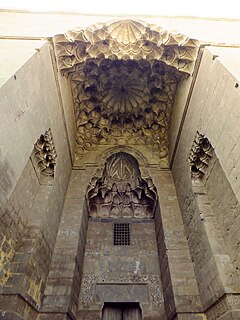
Palace of Yashbak, also known as the Palace of Amir Qawsun, is a semi-ruined palace in Medieval Cairo, Egypt, originally built between 1330 and 1337 CE for the Mamluk amir known as Qawsun. It was restored and expanded again in the 1480s by the amir Yashbak min Mahdi under the reign of Sultan Qaytbay.

The Madrasa of Al-Nasir Muhammad is a madrasa and mausoleum located in the Bayn al-Qasrayn area of al-Muizz street in Cairo, Egypt. It was built in the name of the Mamluk sultan Al-Nasir Muhammad ibn Qalawun, but its construction began in 1296 under the reign of Sultan Al-Adil Kitbugha, who was sultan in between Al-Nasir Muhammad's first and seconds reigns. When Al-Nasir Muhammad returned to the throne in 1299 he oversaw its construction until its completion in 1303. It is adjacent to the earlier hospital and funerary complex of Sultan Qalawun and the later Madrasa of Sultan Barquq.

The Sultan Al-Ghuri Complex or Funerary complex of Sultan al-Ghuri, also known as al-Ghuriya, is a monumental Islamic religious and funerary complex built by Sultan Qansuh al-Ghuri between 1503 and 1505 CE. The complex consists of two major buildings facing each other on al-Mu'izz li-Din Allah street, in the Fahhamin Quarter, in the middle of the historic part of Cairo, Egypt. The eastern side of the complex includes the Sultan's mausoleum, a khanqah, a sabil, and a kuttab, while the western side of the complex is a mosque and madrasa. Today the mosque-madrasa is still open as a mosque while the khanqah-mausoleum is open to visitors as a historic site.

Mamluk architecture was a flowering of Islamic art during the reign of the Mamluk Sultanate (1250–1517), which is most visible in medieval Cairo and is hugely inspired by the former Fatmid and Byzantine architecture of Egypt. Religious zeal made them generous patrons of architecture and art. Trade and agriculture flourished under Mamluk rule, and Cairo, the caliphate's capital, continued to be one of the wealthiest cities in the Near East and the center of artistic and intellectual activity. And as described in the words of Ibn Khaldun, "Cairo is the center of the universe and the garden of the world", with majestic domes, courtyards, and soaring minarets spread across the city.
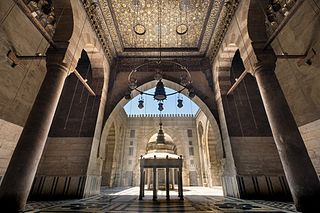
Mosque-Madrasa of Sultan Barquq or Mosque-Madrasa-Khanqah of Az-Zaher Barquq is a religious complex in Islamic Cairo, the historic medieval district of Cairo, Egypt. It was commissioned by Sultan al-Zahir Barquq as a school for religious education in the four Islamic schools of thought, composed of a mosque, madrasa, mausoleum and khanqah. The complex was constructed in 1384-1386 CE, with the dome added last. It was the first architectural facility built during the time of the Circassian (Burji) dynasty of Mamluk Sultanate.
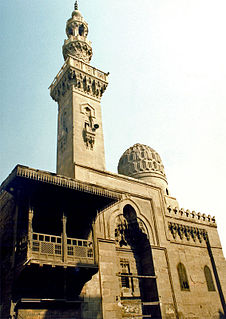
The Funerary Complex of Amir Taghribirdi or Mosque and Madrasa of Taghribirdi is a historical funerary complex of a mosque and madrasa located in Cairo, Egypt and built in the year 1440, during the Mamluk Sultanate. This monument honors Amir Taghribirdi, the mosque's commissioner and the secretary to Sultan al-Zahir Jaqmaq. The mosque and madrasa of Taghribirdi is located on a corner of Saliba street. This is not to be confused with a different Mosque of Taghribirdi, which is located in the Darb al-Maqasis neighborhood of Cairo.

The Al-Ashraf Mosque or the Mosque-Madrasa of Sultan al-Ashraf Barsbay is a historical complex of mosque and madrasa located in Cairo, Egypt. The mosque was built during the Mamluk period by the Burji Sultan Al-Ashraf Al-Barsbay. The complex consists of a mosque-madrasa, mausoleum, and Sufi lodgings. The mosque is characterized by its design, which incorporates marble and stained-glass windows.

The Wikala of Sultan Qaytbay or Wakala of Sultan Qaytbay is an urban caravanserai and rab built by Sultan al-Ashraf Abu al-Nasr Qaitbay in 1481 CE in Islamic Cairo, the historic medieval district of Cairo, Egypt.

The Mosque ofAmir Qijmas al-Ishaqi or Abu Hurayba Mosque is a late Mamluk-era mosque in Cairo, Egypt. It dates from 1480-81 CE and is located in the historic al-Darb al-Ahmar district, near Bab Zuweila. It is considered by many to be one of the finest examples of late Mamluk architecture.

The Khanqah of Faraj ibn Barquq is a religious Islamic funerary complex built by the Mamluk Sultan Faraj ibn Barquq from 1400 to 1411 CE. It is located in Cairo, Egypt, in the Northern Cemetery which is a part of Cairo's historic necropolis districts. It is often considered one of the most accomplished works of Mamluk architecture in Cairo, and one of the major monuments of the Northern Cemetery district.

The Sultaniyya Mausoleum is a Mamluk-era funerary complex located in the Southern Cemetery of the Qarafa, the necropolis of Cairo, Egypt. It is believed to have been built in the 1350s and dedicated to the mother of Sultan Hassan. It is notable for its unique pair of stone domes.

The Khanqah and Mausoleum of Sultan Barsbay or Complex of Sultan Barsbay is an Islamic funerary complex built by Sultan al-Ashraf Barsbay in 1432 CE in the historic Northern Cemetery of Cairo, Egypt. In addition to its overall layout and decoration, it is notable for the first stone domes in Cairo to be carved with geometric star patterns.

The Madrasa of Umm al-Sultan Sha'ban is a Mamluk-era complex located in the Al-Darb al-Ahmar area of Islamic Cairo in Egypt. It was founded or built in 1368-69 CE on the order of Sultan al-Ashraf Sha'ban in honour of his mother, Khawand Baraka. It is located outside Bab Zuweila along al-Tabbana street, and is adjoined to the north by the Bayt al-Razzaz palace. The complex is made up of a college (madrasa), mausoleum, water trough (hawd), and a primary school (maktab).

The Maristan of al-Mu'ayyad or Bimaristan al-Mu'ayyadi is a bimaristan constructed by the Mamluk sultan al-Mu'ayyad Sheikh between 1418 and 1420. It is located on the southern edge of the Darb al-Ahmar district in Cairo, Egypt, near the Citadel of Cairo and the former Bab al-Wazir gate. It did not serve its function as hospital very long and stood ruined for many years. Its facade and main walls have survived, and have been recently restored.

